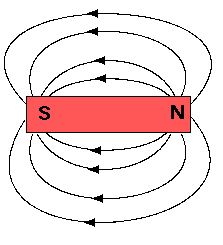New Terms and Ideas
|
Back to Yr 10 Index Page
The Domain Theory.
The basic principle of electromagnetism is that moving electrons have a magnetic field.In an atom, electrons are orbiting the nucleus, (as the earth orbits or revolves around the sun) and also, each electron rotates or spins on its axis. ( like the earth does).
Because of this revolving and rotating, each electron has its own magnetic
field.
In the atoms of most elements, the magnetic fields of all the electrons
in the atom cancel each other out, and the atom has no overall magnetic
field.
In just a few, they don't, and so the individual atoms behave like tiny magnets. These elements are called ferromagnetic elements, and the most common are Iron (Fe), Nickel (Ni) and Cobalt (Co).
In a piece of iron, nickel or cobalt, groups of these atoms line up together to form small areas (about 1mm wide) called domains.


|

|
An ordinary piece of iron which has been magnetised soon looses its magnetism
The Earth's Magnetic Field.
| The ancient Greeks found that pieces of certain naturally occurring
minerals pointed north when suspended on a string.
Since these minerals were originally found near Magnesia in Turkey, they were called magnets.They are also called lodestones. At first people thought magnets pointed north because there was a great pile of lodestone at the North Pole. Eventually, it was realised that the whole earth has a magnetic field,
with a North and South Magnetic Pole.
The magnetic North pole is not fixed in one place, but moves over time. It is not necesarily found at the same place as the geographic North pole. |
 |
The magnetic field of a current carrying wire.
An electric current is many electrons moving. Since moving electrons have a magnetic field, a current carrying wire is surrounded by a magnetic field. Experiments have shown this field to be circular.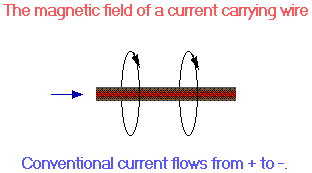
The field exists all along the wire. Electricians use a device which
detects magnetic fields to locate wires behind walls.
The direction of the field depends on the direction of the current.
The current flow shown here is conventional flow, ie positive to negative,
and not electron flow.
The magnetic field of a current carrying coil of wire
| If a current carrying wire is wound up into a coil, then the individual
circular fields of the loops combine to produce a field like that
of a bar magnet.
The direction of the field depends on the
direction of the current.
|
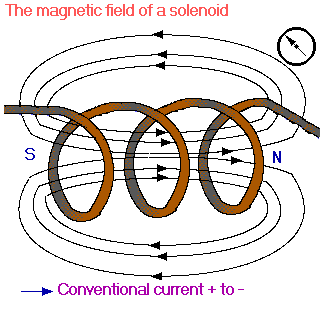 |
The ElectromagnetThe field of a solenoid is not very strong on its own. However, if a bar of iron is placed inside the coil, the domains in the bar will line up with the field of the solenoid to form a strong magnet.An electromagnet loses its magnetic field very quickly once the current flow stops. If the size of the current is increased, the strength of the electromagnetic field increases. If the number of coils is increased, the strength of the electromagnetic
field increases.
Electric doorbells, and magnetic recording devices are two applications
of electromagnets.
|
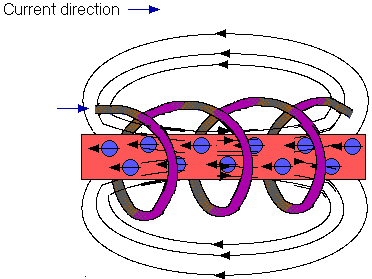
Click to see it happen. |
The interaction of the fields of current carrying wires and coils and other magnets
When a wire or solenoid is placed in the field of a second magnet, the magnetic field of the wire or solenoid will interact with the magnetic field of this magnet. If the second magnet is fixed in position, then the wire or coil will be repelled or attracted, depending on the direction of the current.
The loud speakerLoud speakers consist of a coil that is tightly wound around the base of a speaker cone.The voice coil,as it is called, and the cone sit inside a cylindrical permanent magnet.The speaker opposite is a model you can easily make. An alternating (AC) current flows through the coil. This causes the direction of the voice coil's field to change as rapidly as the current direction changes. The voice coil is alternatively repelled and attracted to the permanent magnet. Since the voice coil is firmly attached to the cone, the cone vibrates. This causes the air near it to vibrate as well, and we hear this as sound. The loud speaker converts electrical energy into kinetic and then sound energy. You will also find that the coil on your model gets quite hot if you try to pass too much current through it. |
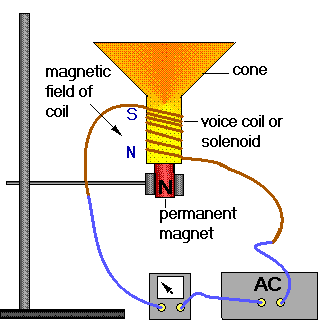
|
The DC motorThe DC motor converts electrical energy into kinetic and heat energy.The diagram opposite is a stylised end on view of the Motor construction kits we used in class. Only one loop of one rotor coil is shown. Current flows up the positive brush terminal, onto the split ring commutator, around the loop and off the negative terminal. Thus each side of the loop experiences a force in the opposite direction to the other, and the loop rotates around the shaft. |
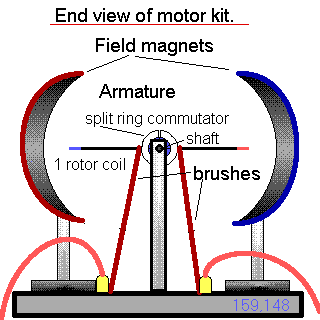 |
Credits
- pictures drawn by Sally Mack using NeoPaint and PaintBrush
- animated using GIF MovieGear
- trialled by year 10 science students Somerville House
- copyright Somerville House 1999
- updated 14/6/99
